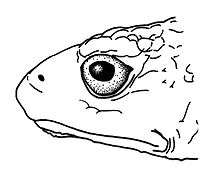Osornophryne bufoniformis
Osornophryne bufoniformis is a species of toad in the family Bufonidae. It is found in the Andes of southern Colombia (Colombian Massif) and northern Ecuador.[1][2][3][4] Common name Peracca's plump toad has been proposed for it,[2][3][5] in allusion to Mario Giacinto Peracca, the scientist who described this species in 1904.[5]
| Osornophryne bufoniformis | |
|---|---|
 | |
 | |
| Lateral view of the head of female (top) and male (bottom) O. bufoniformis | |
| Scientific classification | |
| Kingdom: | Animalia |
| Phylum: | Chordata |
| Class: | Amphibia |
| Order: | Anura |
| Family: | Bufonidae |
| Genus: | Osornophryne |
| Species: | O. bufoniformis |
| Binomial name | |
| Osornophryne bufoniformis (Peracca, 1904) | |
| Synonyms[2] | |
|
Atelopus bufoniformis Peracca, 1904 | |
Description
Adult males measure 16–23 mm (0.6–0.9 in) and adult females 28–36 mm (1.1–1.4 in) in snout–vent length.[3] The occipital ridges are low or absent.[6] The limbs are short and thin. The fingers and the toes have fleshy webbing.[3] The dorsum is covered with numerous round pustules of different sizes.[6] Dorsal coloration is black-brown, dark brown, light brown, or reddish brown. A yellow or light brown glandular dorsolateral line can be present. The belly is light or dark brown with yellow or red pustules.[3]
Habitat and conservation
Osornophryne bufoniformis occurs in montane forests, bush land, and páramo at elevations of 2,800–4,700 m (9,200–15,400 ft) above sea level. They can be found on fallen leaves and on the ground, but also in terrestrial bromeliads and on vegetation up to half a meter above the ground. Development is direct[1] (i.e, there is no free-living larval stage[7]).
It is a rare species that is uncommon even when present. It is threatened by habitat loss (deforestation) caused by agricultural development, cultivation of illegal crops, fire, logging, and human settlements. Pollution resulting from the spraying of illegal crops is also a threat. It is present in several protected areas.[1]
References
- Bolívar, W.; Coloma, L.A.; Ron, S.; Cisneros-Heredia, D. & Grant, T. (2010). "Osornophryne bufoniformis". IUCN Red List of Threatened Species. 2010: e.T54856A11216724. Retrieved 9 February 2020.
- Frost, Darrel R. (2020). "Osornophryne bufoniformis (Peracca, 1904)". Amphibian Species of the World: an Online Reference. Version 6.0. American Museum of Natural History. Retrieved 9 February 2020.
- Coloma, L. A.; et al. (2018). Ron, S. R.; Merino-Viteri, A. & Ortiz, D. A. (eds.). "Osornophryne bufoniformis". Anfibios del Ecuador. Version 2019.0. Museo de Zoología, Pontificia Universidad Católica del Ecuador (QCAZ). Retrieved 9 February 2020.
- Acosta Galvis, A. R. (2020). "Osornophryne bufoniformis (Peracca, 1904)". Lista de los Anfibios de Colombia: Referencia en linea V.10.2020. Retrieved 9 February 2020.
- Beolens, Bo; Watkins, Michael & Grayson, Michael (2013). The Eponym Dictionary of Amphibians. Pelagic Publishing. p. 165. ISBN 978-1-907807-42-8.
- Paez-Moscoso, Diego J.; Guayasamin, Juan M. & Yánez-Muñoz, Mario H. (2011). "A new species of Andean toad (Bufonidae, Osornophryne) discovered using molecular and morphological data, with a taxonomic key for the genus". ZooKeys. 108: 73–97. doi:10.3897/zookeys.108.1129.
- Vitt, Laurie J. & Caldwell, Janalee P. (2014). Herpetology: An Introductory Biology of Amphibians and Reptiles (4th ed.). Academic Press. p. 166.
